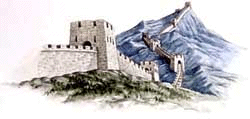DK History: Imperial China
For more than 2,000 years, from 221 BC until AD 1912, China was ruled by emperors. In that time, the capital city and the imperial dynasty (ruling family) changed. There were periods of unrest and of invasion by fierce tribes, including the Mongols, but the same system of government continued. Imperial China was a remarkably stable civilization, which led the world in art and technology, with inventions including paper, PORCELAIN, and gunpowder.
Table 44. CHINA’S RULERS
| 221 BC | Qin dynasty |
| 206 BC | Han dynasty |
| AD 221 | Time of disunity |
| 581 | Sui dynasty |
| 618 | Tang dynasty |
| 907 | China divided into five dynasties |
| 960 | Song dynasty |
| 1279 | Yuan dynasty (Mongol) |
| 1368 | Ming dynasty (last Chinese dynasty) |
| 1644–1912 | Qing dynasty (Manchu dynasty from Manchuria) |
The first Han emperor set up a civil service to run China. Before getting a job in the civil service, officials had to pass a series of difficult exams. Those who passed the top exams could expect jobs as government ministers, and marriage to princesses.
After invading China in AD 1279, the Mongol (Yuan) emperors established their capital at Beijing, which was just inside the Great Wall, in what was then the far north of China. In 1368, a new dynasty, the Ming, came to power. They kept Beijing as the capital, rebuilding and expanding the city.
The imperial palace at Beijing is called the Forbidden City. Enclosed by a moat and high brick walls, this complex of palaces, halls, gardens, offices, and storehouses was built under the Ming dynasty. The imperial family lived there, along with nobles, servants, and officials.
Porcelain is a translucent (semitransparent) ceramic material, made of fine white clay mixed with crushed stone. It can be shaped on a potter’s wheel, or molded by hand. When fired (baked) at extremely high temperatures, it becomes waterproof, and so hard that steel cannot scratch it.
Porcelain was first made by Chinese potters during the Tang dynasty. It was a luxury product, for the use of nobles and emperors, and for centuries no one but the Chinese knew how to make it. Seventeenth-century Dutch sailors brought the first porcelain “china” to Europe, where it was a prized commodity.

